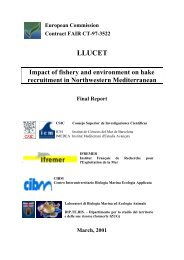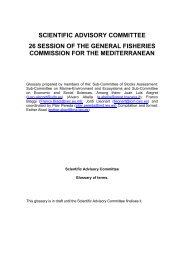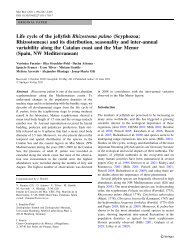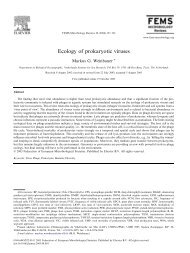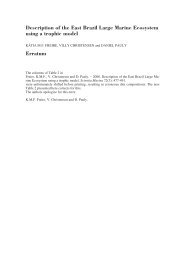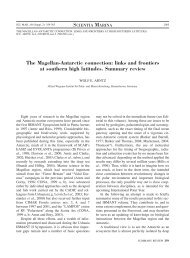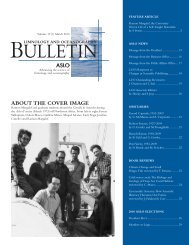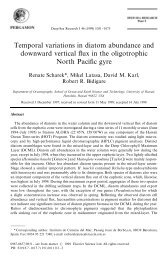REPORT OF THE WORKSHOP ON TRAWL SURVEY ... - FAO.org
REPORT OF THE WORKSHOP ON TRAWL SURVEY ... - FAO.org
REPORT OF THE WORKSHOP ON TRAWL SURVEY ... - FAO.org
Create successful ePaper yourself
Turn your PDF publications into a flip-book with our unique Google optimized e-Paper software.
could be treated as separate.<br />
Some examples of comparative trawling exercises are also given in the IBTSWG reports in<br />
2004 and 2005. For further information on methods of survey gear calibration, see Lewy et al.<br />
(2004).<br />
The 2006 SGSTS meeting provided advice on intercalibration of gears and vessels, based on<br />
material and examples provided by SGSTS (2005) and WKSAD (2004). The question of<br />
when to calibrate changes was broken down to cases of:<br />
- Minor improvements designed to allow better compliance with agreed standards<br />
(advice: do not calibrate). This can include minor changes to components when<br />
they are no longer available with the same specifications as before, or introduction<br />
of better trawl surveillance equipment such as bottom contact sensors.<br />
- Modest changes or departures from agreed standards that will have some effect on<br />
net performance, but whose effects are individually hard to estimate (advice: save<br />
all changes up and introduce in a single tranche, or introduce stepwise to allow<br />
comparison).<br />
- Major changes in gear or standards that depart significantly from the previous ones<br />
(advice: calibrate).<br />
The SGSTS (2006) also examined the main approaches to calibration including comparative<br />
fishing trials, modelling approaches, and gradual incorporation of gear changes to a survey. It<br />
also advised that poor calibration may be worse than no calibration at all, and provides<br />
guidelines for good practice for calibration studies. The SG advises that, before investing in<br />
an intercalibration exercise, careful consideration should be given to the prior expectation of<br />
the magnitude of change in catchability, the ability to deal with multivariate estimation of<br />
different factors for different sizes and species of fish; and the required precision of the<br />
calibration (as evaluated using simulations of the stock assessment process).<br />
Computation of abundance indices<br />
Abundance indices from IBTS and most other ICES surveys are mostly computed as<br />
standardised catches per unit tow duration. The calculation of abundance indices as numbers<br />
per area swept is less common. One example is the Norwegian Bottom Trawl Surveys in the<br />
Barents Sea (ICES Arctic Working Group, 2006). The ability of swept-area estimates to<br />
provide absolute estimates of abundance is very much dependent upon factors such as vertical<br />
distribution of fish and fish behaviour (ship and trawl avoidance).<br />
Norwegian scientists have been active in the use of acoustics to study fish behaviour in<br />
relation to trawls (e.g. Godø 1999), and a recent initiative to use commercial and research<br />
trawlers to obtain a swept-area estimate of anglerfish biomass off Scotland (Reid et al. in<br />
press) has involved underwater video records to examine fish behaviour in contact with trawl<br />
doors and bridles etc. The IFREMER-coordinated EU project “<strong>SURVEY</strong><strong>TRAWL</strong>” in 2003<br />
focused on the design of a trawl that can deliver quantitative estimates of fish density with<br />
minimal herding of fish. Following from this project, IMR in Norway initiated the<br />
“Norwegian Trawl” project to develop a quantitative bottom trawl (see IBTSWG reports in<br />
2004 – 2006 and SGSTS 2005, 2006 for overview of progress).<br />
The procedures for generating abundance indices from IBTS-coordinated surveys are<br />
described in the report of the EU contract EVARES (Beare et al. 2003). The indices for the<br />
49



